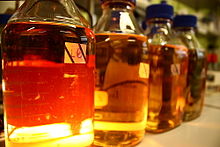LB培养基

LB培养基(Lysogeny broth,LB),是微生物学实验中最常用的营养性培养基,用于培养大肠杆菌等细菌,分为液态培养基和加入琼脂制成的固态培养基。加入抗生素的 LB 培养基可用于筛选以大肠杆菌为宿主的选殖。
名称[编辑]
尽管该培养基的名称被广泛解释为Luria-Bertani 培养基,然而根据其发明人贝尔塔尼(Giuseppe Bertani)的说法,这个名字来源于英语的 lysogeny broth,即溶菌肉汤[1]。
配方[编辑]
LB 培养基的配方发表于1951年有关溶源性的论文中。用于使志贺氏菌属的细菌增长[1][2]。
LB培养基在1950年代曾被用作培养大肠杆菌的业界标准配方[3][4][5][6][7]。它还被广泛应用于分子微生物学以及质体DNA的制备上,是重组大肠杆菌DNA时最常用的培养基[8]。但LB培养基不鼓励应用于生理学研究上[9]。
每个LB培养基的配方不尽相同,但大概都会包含下列几项:
一升水中加入:
1951年的原始论文中,贝尔塔尼在1升的水中加入了10克的氯化钠、1克的葡萄糖[6],但之后便剔除掉了葡萄糖。
氯化钠的量经常随细菌的生长需求不同而有所改变,像盐分较低的Lennox和Luria培养基就适用于对于盐分较敏感的抗生素实验上[10]。
- LB-Miller (10 g/L NaCl)
- LB-Lennox (5 g/L NaCl)
- LB-Luria (0.5 g/L NaCl)
制备方法[编辑]

加水至1L并调pH值至7.0后高温灭菌。如需要制成固态培养基,在调pH值后加入1.5%(质量体积比,即每升培养基中加入15克)的琼脂再灭菌。
参见[编辑]
参考文献[编辑]
- ^ 1.0 1.1 Giuseppe Bertani. Lysogeny at mid-twentieth century: P1, P2, and other experimental systems. Journal of Bacteriology. 2004-02, 186 (3): 595–600 [2019-02-13]. ISSN 0021-9193. PMC 321500
 . PMID 14729683. doi:10.1128/JB.186.3.595-600.2004. (原始内容存档于2019-08-13).
. PMID 14729683. doi:10.1128/JB.186.3.595-600.2004. (原始内容存档于2019-08-13).
- ^ Bertani, G. (1951). Studies on lysogenesis. I. The mode of phage liberation by lysogenic Escherichia coli. J. Bacteriol. 62:293-300. PMID 14888646 PDF
- ^ Miller, J. H. (1972). Experiments in molecular genetics. Cold Spring Harbor Laboratory, Cold Spring Harbor, New York.
- ^ Luria, S. E., J. N. Adams, and R. C. Ting. (1960). Transduction of lactose-utilizing ability among strain of E. coli and S. dysenteriae and the properties of the transducing phage particles. Virology. 12:348-390. PMID 13764402
- ^ Lennox, E. S. (1955). Transduction of linked genetic characters of the host by bacteriophage P1. Virology. 1:190-206. PMID 13267987
- ^ 6.0 6.1 Luria, S. E., and J. W. Burrous. (1957). Hybridization between Escherichia coli and Shigella. J. Bacteriol. 74:461-476. PMID 13475269 PDF
- ^ Anderson, E. H. (1946). Growth requirement of virus-resistant mutants of Escherichia coli strain B. Proc. Natl. Acad. Sci. USA 32:120-128. PMID 16588724
- ^ Sambrook, J., E. F. Fritsch, and T. Maniatis. (1989). Molecular cloning: a laboratory manual, 2nd edition. Cold Spring Harbor Laboratory, Cold Spring Harbor, New York.
- ^ Nikaido, H. (2009). The Limitations of LB Medium. Small things considered - The Microbe Blog. ASM. http://schaechter.asmblog.org/schaechter/2009/11/the-limitations-of-lb-medium.html (页面存档备份,存于互联网档案馆)
- ^ Commonly used bacterial E.coli growth media. Expression Technologies Inc. http://www.exptec.com/Reagents/Common%20Media.htm (页面存档备份,存于互联网档案馆)
